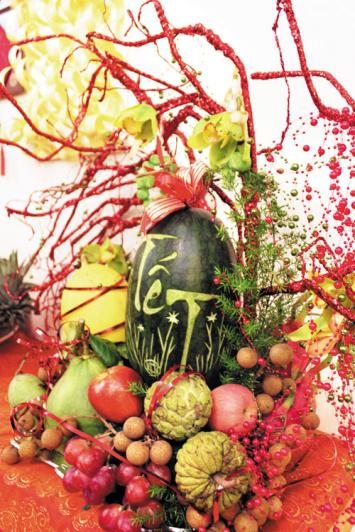For a long time, together with horizontal lacquered boards engraved with Chinese characters, parallel sentences written on crimson paper, ornamental kumquat and peach trees, and popular Hang Trong and Dong Ho pictures, the five‑fruit tray prepared for Tet has transcended its material value to become a spiritual symbol, an original national product in the spiritual life of the Vietnamese. At present, while many of the ancient spiritual values have sunk into oblivion, the custom of arranging the five‑fruit tray on the altar during the lunar New Year days is being jealously preserved as a fine legacy of Vietnam’s traditional culture. The buying of votive offerings and the decoration of ancestral altars during the traditional New Year days are closely connected with the rituals of worship practiced by the Vietnamese towards their ancestors. During these New Year days, in addition to such national dishes and products as “Fat pork, salted onions, parallel sentences written on red paper. Long bamboo poles planted upright, strings of fireworks, and square glutinous rice cakes”, it is indispensable for each Vietnamese family to display a five‑fruit tray on the ancestral altar for Tet.
No matter whether rich or poor, on New Year’s Eve, it is also very important for the Vietnamese to select the best five-fruit tray. The fruits are placed on a red-lacquered wooden tray and arranged in a balanced cone and in harmonious colours. Fruits that may be laid out on the tray include bananas, finger citrons, watermelons, oranges, kumquats, coconuts, apples, persimmons or tomatoes, and chilis. Each kind of fruit has its own indication. A hand of green bananas or a finger citron, for example, symbolises one’s wish for the protection of supernatural powers and ancestors, pomelos and watermelons indicate fertility, and kumquats or persimmons connote wealth and prosperity.

Mam Ngu Qua – sends Tet traditional flavours
Custom of the five‑fruit tray…
One theory says that the five fruits are symbolic of the five basic elements of oriental philosophy – metal, wood, water, fire and soil. Other theories regard the tray as symbolic of the fruits of a family’s hard work throughout the past year, which are consecrated to heaven and earth and their ancestors as sign of respect and gratitude.
A five-fruit tray, though varying from one region to another due to differences in climate and fruit crops, light up altars with their ample colours. In northern areas, five-fruit trays ornamented with pomelos, peaches, kumquats, bananas and persimmons are relatively smaller than those in southern areas with pairs of watermelons, coconuts, papayas, custard apples, mangos, and figs. Improvements in people’s living conditions in recent years have led to a greater sophistication in choosing fruits for the altar for the Tet holiday. A tray may contain more expensive, rarer fruits like grapes and pears, but all in all it is still a five-fruit tray, a nice offering of the Vietnamese people to their ancestors. It not only displays a life-long tradition but also sends a message of hope for happiness, good luck and prosperity for the new year.
The custom of displaying the five‑fruit tray as votive offerings at the holy place of the house has been reflected in many popular legends and tales. It has originated from ancient popular beliefs observed from one generation to another in their worship towards their forefathers. To this day, the Vietnamese still observe a long‑standing custom of placing the first ripe fruits harvested from the home garden on the altar and burning incense sticks in memory of their ancestors.
Preparation for a five‑fruit tray
Like other popular rituals, the preparation of a five‑fruit tray for Tet has become an established convention. Although it is called a five‑fruit tray, it does not necessarily contain exactly five kinds of fruit. Arranging fruits on the crimson, hourglass‑shaped wooden tray is really an art. One has to combine the colours and shapes of the different fruits in arranging them on the tray to make it look like a still life picture.
To ensure balance on the tray, one usually places the hand of bananas in the middle with the bananas pointing upright and the pomelo on the concave surface of the hand of bananas. Then one puts the oranges, sapodilla plums, apples, etc. in the gaps between the bananas and the pomelo. The last little gaps are filled in with little kumquats to create a full, compact tray of fruits. In colours, the fruit‑tray presents a harmonious combination of the different colours of fruits: dark green of banana, light yellow of pomelo, deep red of persimmon, reddish‑yellow of orange and kumquat, light green of apple, and dark brown of sapodilla plum. To complete the picture, the fruit‑tray will be covered here and there with some small, fresh leaves of kumquat.
The “Mam Ngu Qua” in Tet festival represent the quintessence that Heaven and Earth bless humans. This is one of the general perceptions of life of the Vietnamese, which is “Ăn quả nhớ kẻ trồng cây” (“When taking fruit, you should think of the grower”)
Danh du” (Swings) have been traditional game at Vietnamese village festivals for centuries. The game is most...
Longevity wishing ceremony is to wish an elderly person longevity. That is a Vietnamese custom, when their grandparents...
The “khan dong” is a black piece of fabric wrapped around a girl’s long hair so that it forms a tube around...
Though today, people in Vietnam use the western calendar for most practical matters of daily life, the old system still...
Throughout centuries, traditional crafts and craft villages have been existed and developed as an integral part of Thai...
Composing, challenging and displaying parallels represents an elegant cultural activity of the Vietnamese people. On...
In the old days, when comics and illustrated books had yet come into existence in Vietnam, “tò he” was made to...
“Diều sáo” (kite flying) are Vietnamese kites that make music, so interesting! If you are in Vietnam, you will...